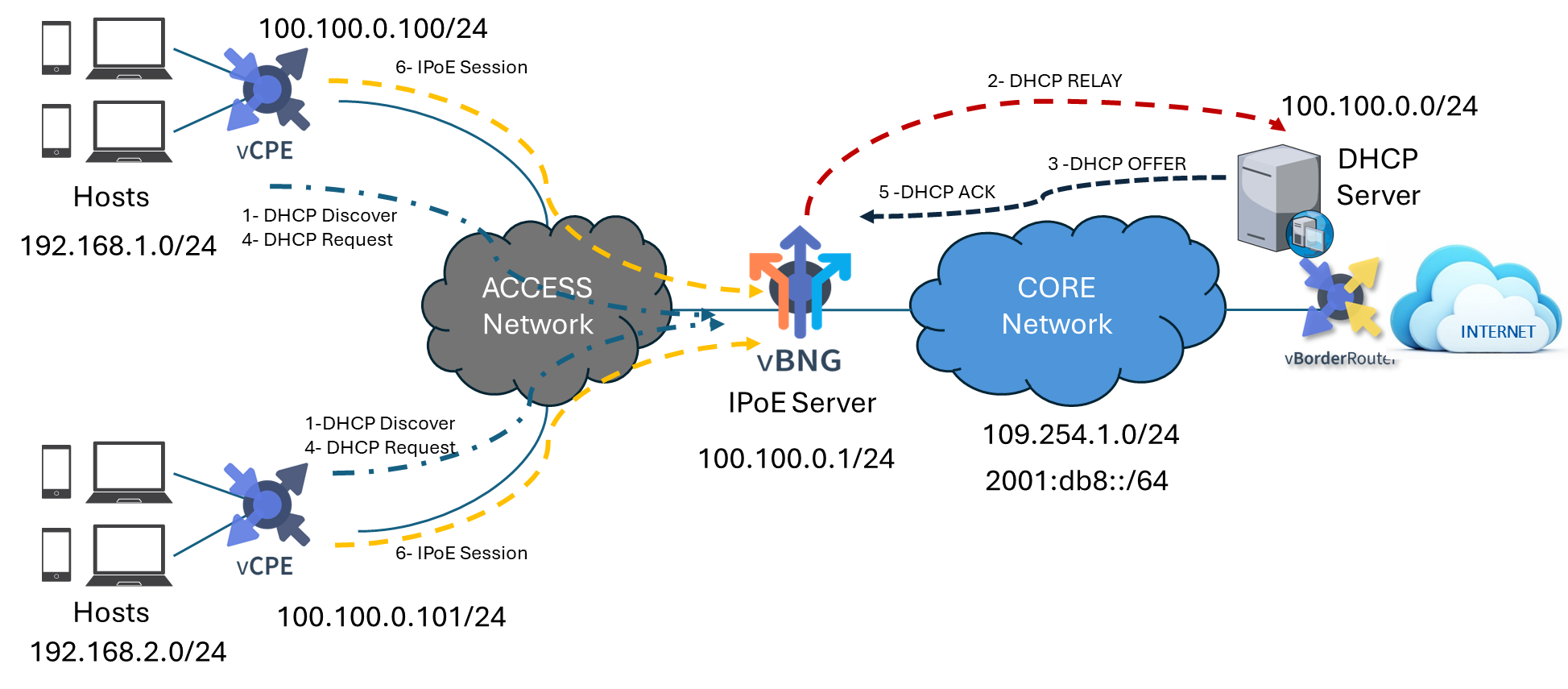5. IPoE Use Case description¶
The following diagram shows the architecture that has been deployed for the BNG IPoE v4 use case.

Clients 1 and 2 represent end users sitting behind their respective CPE, the latter initiating the IPoE session towards the 6WIND BNG router. The AGG is a router or switch that aggregates multiple CPEs acting as the MSAN (Multi Service Access Node) that would route the IPoE session towards the BNG. The BNG is configured as a DHCP relay pointing towards a DHCP server. In our example, we have defined the DHCP Server on the Internet1 Router, but this can be any server reachable in the network.
The 6WIND BNG is configured with a IPoE server function that supports the following DHCP features that are key to our implementation and the establishment of the IPoE session:
IPoE DHCP relay: When a DHCP client requests an IP address, it transmits a DHCPDISCOVER message. This message is a broadcast that targets all devices on the local subnet. Since routers inherently prevent broadcasts from reaching other subnets, the DHCP server must implicitly reside in the same local Ethernet segment, unless an intermediate delivery mechanism is in place.
In many large networks, it is neither possible nor efficient to have a DHCP server on every Ethernet segment. Therefore it would be preferred to have centralized DHCP servers serving multiple sites. More often, these servers are not on the same Layer 2 domain as the clients they serve. This is where the DHCP relay agent comes into play, acting as an intermediary to forward client broadcast requests to one or more servers, and reciprocally retransmit server responses back to clients. The Virtual Service Router’s IPoE server solution only supports the use of DHCP as a relay agent as of this release.
Agent Information: GIADDR and DHCP option 82: The DHCP relay agent writes the value of relay-address into the DHCP GIADDR header of the end device DHCP request and retransmits the packet to the designated servers from the relay-agent-address source IP address. If another relay agent subsequently receives this packet, the source IP address of the packet is changed, but the GIADDR header remains the same.
Known as “Relay Agent Information”, DHCP option 82, specified in RFC 3046, can provide additional context on the relay agent. If the DHCP request does not yet contain the GIADDR and option 82, the relay agent can optionally insert this information if either the remote-id or link-selection parameters are set.
The remote-id global option sets sub-option 2 of option 82. It globally identifies remote end devices through a specific string.
On the other hand, the link-selection option refers to sub-option 5 of option 82 which is detailed in RFC 3527. Its purpose is to provide the DHCP servers with the IP address of the IPoE server interface, especially when this address differs from the GIADDR.
The DHCP GIADDR header and DHCP option 82 can help DHCP servers determine the appropriate pool for IP address allocation. They are also frequently used to log the IP address locations.
The trusted-circuit parameter determines whether the relay agent should forward DHCP requests that already transited via a relay agent, either with a valid GIADDR header or with DHCP option 82 By default, the value is false, meaning these requests are considered as untrusted. This prevents the relay agent from forwarding DHCP requests containing authentic or fake information about the agent. If the parameter is set to true, incoming DHCP requests are accepted and forwarded, provided their GIADDR header does not spoof the local GIADDR value.
DHCP Client’s identification of the Router and Relay Agent: The DHCP option 54, referred to as the “Server Identifier”, is set by the DHCP server to include its own IP address in the responses it sends. A standard relay agent transmits this option unaltered. Subsequently, following the DHCP lease’s initialization, the DHCP client interacts directly with the DHCP server, bypassing the DHCP relay agent. However, since the IPoE relay is designed to forward all DHCP interactions to preserve IPoE sessions, it swaps the “Server Identifier” in option 54 with its own IP address. Inversely, the relay agent replaces the “Server Identifier” value in client requests with the real server IP. The router setting determines the IP address that the relay should present to clients via DHCP option 54. If this setting is undefined, the system automatically defaults to a local IP address.
The DHCP option 3, known as the “Router” option, provides the end device with a default gateway. The router setting determines the value set in DHCP option 3. Any pre-existing option 3 value from the DHCP server is substituted with this router setting. If left unspecified, the relay agent retains the original value of option 3.